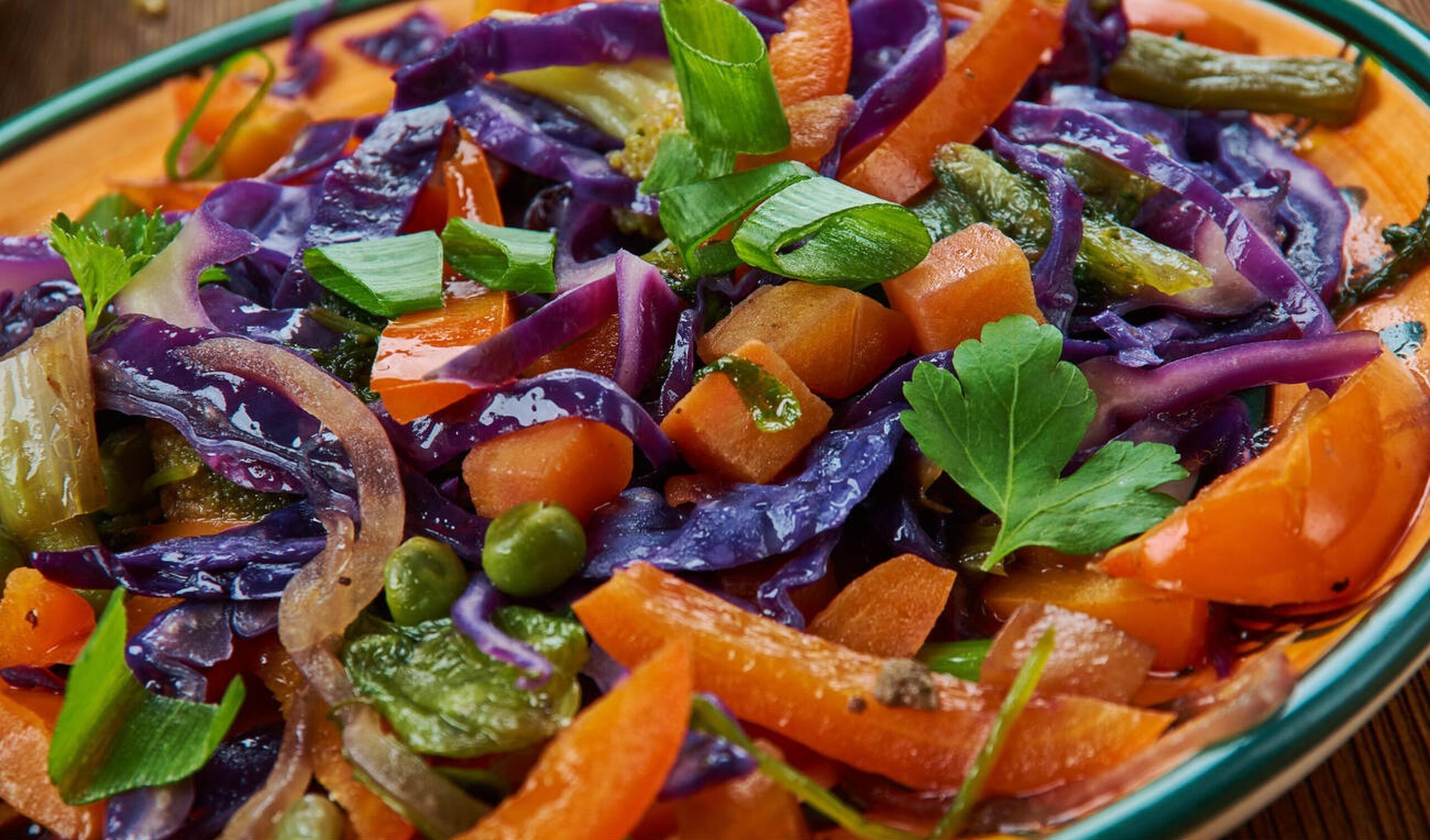This recipe explores the world of Mongolian vegetables, showing their importance, popular types, cooking methods, and ways to use them in traditional recipes.
The nomadic culture of the nation and the natural abundance of its vast landscapes have a profound impact on Mongolian food, which is a brilliant tapestry of flavors, textures, and colors.
In traditional Mongolian cuisine, meat frequently takes center stage, but vegetables are just as vital to the creation of well-balanced, nutrient-dense, and delectable meals.
Ingredients
2 cups all-purpose flour
1/2 cup water
1/2 teaspoon salt
1 cup finely chopped cabbage
1 cup grated carrots
1/2 cup finely chopped onions
2 cloves garlic, minced
Salt and pepper to taste
A splash of soy sauce (optional)
Sesame oil for flavor (optional)
Mongolian Vegetables Stir Fry
Making the dough for the buuz is the first step in starting your culinary journey with this recipe. Put the salt and all-purpose flour in a mixing basin. While kneading, gradually add water until the dough is smooth. Let it rest for approximately half an hour after covering it with a moist cloth.
In a bowl, combine the chopped cabbage, grated carrots, onions, minced garlic, salt, pepper, and soy sauce to make the vegetable filling while the dough is resting. Mix thoroughly until the seasoning is uniformly distributed over all the components.
After the dough has had time to rest, roll it into golf-ball-sized pieces. On a board dusted with flour, roll each ball out into thin circles. In the middle of each circle, place a spoonful of the veggie filling.
Create pleats by folding the edges over the filling to form your buuz, then pinch them together at the top to ensure a tight seal. Continue doing this until all of the dough and filling have been used.
Next, set up your steamer by boiling water in a saucepan or wok that has a steaming rack or basket that is lined with parchment paper to keep it from sticking. Don’t put too many of your buuz on the rack.
After 15 to 20 minutes of steaming, the buuz should be firm to the touch and translucent. For extra taste, sprinkle sesame oil or soy sauce over the hot dish.
See also: Moroccan beef stew with chickpeas
Additional Ways to Enjoy Mongolian Vegetables
Although buuz is a delectable way to eat Mongolian vegetables, there are a ton of different ways to prepare them that are worth trying:
Stir-fried vegetables
When served with rice or noodles, a simple stir-fry with seasonal veggies like bell peppers, carrots, onions, and garlic makes a great side dish or main course.
Salad with Cabbage
In contrast to heavier meat meals, a simple salad consisting of grated carrots and shredded cabbage seasoned with sesame oil or vinegar is refreshing.
In addition to being nutritional, a hearty vegetable soup cooked with boiling potatoes, carrots, onions, garlic, and any available greens offers solace in chilly weather.
Vegetables Pickled
Making fast pickles with cucumbers or radishes preserves seasonal vegetables and adds tangy flavor profiles that can improve any meal.
Storing Mongolian Stir-Fry
Depending on your needs, Mongolian stir-fries, which frequently contain meat and a range of vegetables, can be kept in the freezer or refrigerator.
Any leftover stir-fry should be refrigerated in an airtight container. You can keep it in the refrigerator for up to four days. Before sealing, make sure the dish is entirely cool to prevent condensation, which can cause sogginess.
Freezing: Freezing is a great way to preserve your stir-fry for a longer amount of time. However, since bell peppers tend to get mushy when thawed, it’s best to remove them before freezing. Put the stir-fry in a freezer-safe bag or container and mark the date on it. It keeps for up to four months in the freezer. Thaw overnight in the fridge before warming when ready to eat.
Nutritional Benefits of Mongolian Vegetables
Numerous health advantages of Mongolian vegetables enhance general wellbeing:
Packed with Nutrients: Vitamins C and A are found in many root vegetables, including potatoes and carrots.
High Fiber Content: Dietary fiber, which helps with digestion, is abundant in vegetables like radishes and cabbage.
Low Calorie: Most veggies are great options for people trying to maintain or reduce weight because they are large in volume yet low in calories.
Antioxidant Properties: The antioxidants in onions and garlic assist the body fight against oxidative stress.
Hydration: Due to their high water content, many vegetables help people stay hydrated, which is particularly crucial in Mongolia’s arid climate.
In Mongolia, veggies are more than just side dishes; they are vital elements that improve the whole meal. Traditional Mongolian food depends on seasonal crops that can survive the hard winters because the country’s climate restricts agricultural diversification. The mainstays of the Mongolian cuisine include hardy legumes, leafy greens, and root vegetables, which provide tastes and vital elements to the meat’s flavorful flavor.
Freshness and simplicity are key components in Mongolian food. To retain their natural qualities, vegetables are frequently prepared using simple methods like steaming, boiling, or stir-frying. The natural flavor of the veggies is highlighted by the sparing use of herbs and spices. This method symbolizes the nomadic lifestyle, where meals are frequently prepared over an open flame, while also showcasing the quality of the vegetables.
Final Thoughts
Because of its emphasis on seasonal food and rich cultural past, Mongolian cuisine offers a wide variety of delectable vegetable selections. You may enjoy the distinct flavors and nutritional advantages of these robust products by incorporating them into your meals, whether through modern adaptations or classic dishes like buuz.
Investigating Mongolian veggies honors long-standing customs based on simplicity and freshness while opening up new culinary creative possibilities.

